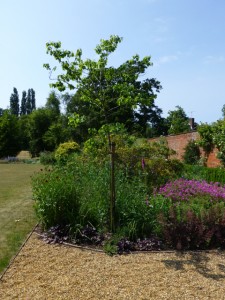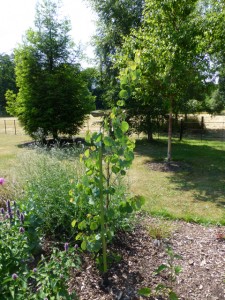
Larger specimens of trees are tempting to buy for instant impact. But does the promise translate in more bang for your bucks? Disease and ill health are romping through our native trees and ash dieback -
Chalara fraxinea and sudden oak death, caused by
Phytophthora ramorum - bring a thought that it may be time to put the greedy tree mentality to one side. The smaller tree, they say, will catch up with the larger one. It will adapt itself much better to its new living quarters.
So here is an experiment with 2
Cercis siliquastrum on a light sandy soil - same massive flower bed - different ends. The first specimen was bought for £279 in December 2010 (including hefty freight cost) Height on planting was round about 4 metres. It is standing and gasping and wheezing at its stake, throwing it s head around in a dangerous snapping way in any breeze that is strong. This tree is known for being shallow rooted and being mobbed by vigorous perennials probably does not help. Heavy draughts of water get sucked up in dry weather but the leaves never look better than pinched green and stressed.
Down the other end of the bed, a young Judas tree was planted last October 2012. A mere slip of a tree at 1.20 metres but its leaves are large and pumped up and the growth hormones are surging through it. Cost £35.

The suspicion is that in 5 years time it will have raced past the grand-daddy. I'll track its progress.
 Larger specimens of trees are tempting to buy for instant impact. But does the promise translate in more bang for your bucks? Disease and ill health are romping through our native trees and ash dieback - Chalara fraxinea and sudden oak death, caused by Phytophthora ramorum - bring a thought that it may be time to put the greedy tree mentality to one side. The smaller tree, they say, will catch up with the larger one. It will adapt itself much better to its new living quarters.
So here is an experiment with 2 Cercis siliquastrum on a light sandy soil - same massive flower bed - different ends. The first specimen was bought for £279 in December 2010 (including hefty freight cost) Height on planting was round about 4 metres. It is standing and gasping and wheezing at its stake, throwing it s head around in a dangerous snapping way in any breeze that is strong. This tree is known for being shallow rooted and being mobbed by vigorous perennials probably does not help. Heavy draughts of water get sucked up in dry weather but the leaves never look better than pinched green and stressed.
Down the other end of the bed, a young Judas tree was planted last October 2012. A mere slip of a tree at 1.20 metres but its leaves are large and pumped up and the growth hormones are surging through it. Cost £35.
Larger specimens of trees are tempting to buy for instant impact. But does the promise translate in more bang for your bucks? Disease and ill health are romping through our native trees and ash dieback - Chalara fraxinea and sudden oak death, caused by Phytophthora ramorum - bring a thought that it may be time to put the greedy tree mentality to one side. The smaller tree, they say, will catch up with the larger one. It will adapt itself much better to its new living quarters.
So here is an experiment with 2 Cercis siliquastrum on a light sandy soil - same massive flower bed - different ends. The first specimen was bought for £279 in December 2010 (including hefty freight cost) Height on planting was round about 4 metres. It is standing and gasping and wheezing at its stake, throwing it s head around in a dangerous snapping way in any breeze that is strong. This tree is known for being shallow rooted and being mobbed by vigorous perennials probably does not help. Heavy draughts of water get sucked up in dry weather but the leaves never look better than pinched green and stressed.
Down the other end of the bed, a young Judas tree was planted last October 2012. A mere slip of a tree at 1.20 metres but its leaves are large and pumped up and the growth hormones are surging through it. Cost £35.
 The suspicion is that in 5 years time it will have raced past the grand-daddy. I'll track its progress.
The suspicion is that in 5 years time it will have raced past the grand-daddy. I'll track its progress. 